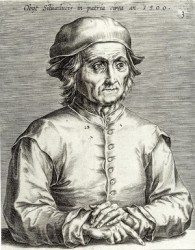
Gossart 1907
Jérôme Bosch. Le “faizeur de Dyables” de Bois-le-Duc (M.-G. Gossart) 1907
[Imprimerie Centrale du Nord, Lille, 1907, 321 pages]
[Also mentioned in Gibson 1983: 6 (A28)]
First Gossart sums up the things we know with certainty about Bosch (anno 1907!). Then he analyses the catalogue of and the influences on his oeuvre. Gossart is in favour of a cultural-historical approach of Bosch: although the culture in the Netherlands was not isolated from the culture in France and Germany, primarily the secret of this special artist has to be looked for in the spiritual life, art and literature of the ‘Dutch Brabant’ area [13/15/16/31].
Bosch is the final product of the Middle Ages: his oeuvre shows naturalistic and satirical, symbolical and moralizing and phantastic and diabolical tendencies and thus offers a summary of the medieval spirit [76-78/116]. His style is characterized by the fact that the central motif is surrounded by a great number of details so that the viewer’s attention is not able to focus on one point [109]. Bosch is the creator of the painted diablerie and believes in the devil [276-277]. His tendency towards the mysterious and the phantastic is typically Dutch and more precisely Germanic [278-279]. According to Gossart a further study of fifteenth-century German art (Lochner, Schongauer, Grünewald, Breu) would reveal quite a number of parallels with and perhaps even influences on Bosch [281].
Gossart’s monograph is divided in two parts. In the first part he analyses Bosch’s life and works, in the second he offers a broad panorama of the naturalism and the satire, the symbolism, the phantastic, the diabolical and the popular spirit in the medieval Netherlands. In five appendixes he provides the reader with catalogues of Bosch’s works, of engravings by Alart du Hameel, of the Spanish Royal Collections, of Bosch portraits and of the most important public sales of Bosch works.
It stands to reason that Gossart’s text contains a number of minor errors and of wrong opinions that in the meantime have been corrected and adjusted by later Bosch scholars. Examples are his opinion that the Prado Adoration of the Magi and the Cologne Adoration of the Child are both works from Bosch’s youth [80] and his erroneous reading of the name Lubbert Das on the Prado Cutting of the Stone as ‘Bibbert Das’ [87]. Striking is his description of the people on top of the haywain on the central panel of the Haywain triptych: “ (…) des femmes nues, la vaine Renommée, la Gloire fragile sonnent de la trompette” [97] [naked women, vain Fame, fragile Glory blow the trumpet]. When describing this detail Gossart apparently makes the same error as José de Siguença in 1605, as no naked women can be observed on the central panel…
[explicit]